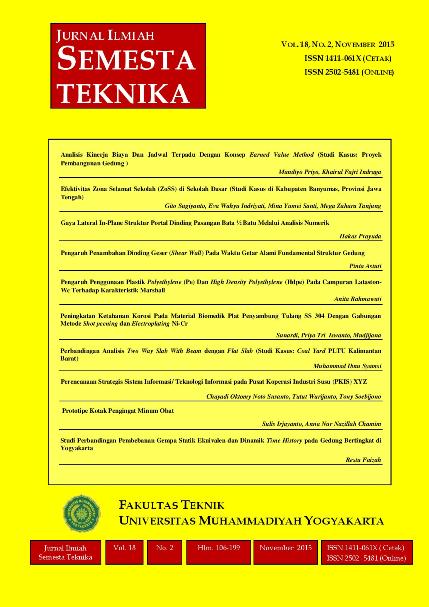Efektivitas Zona Selamat Sekolah (ZoSS) di Sekolah Dasar(Studi Kasus di Kabupaten Banyumas, Provinsi Jawa Tengah)
DOI:
https://doi.org/10.18196/st.v18i2.1813Keywords:
School safety zone, 4-T procedure, pedestrian, elementary schoolAbstract
Many elementary schools in a city or district in Indonesia located on the edge of the highway (arterial road or collector road), with many vehicles are driving at high speed. In these circumstances it is very dangerous for school children as a pedestrian or vulnerable road user. In response, the government implemented a program like School Safety Zone (Zona Selamat Sekolah ” ZoSS”) to anticipate the movement of school children who are spontaneous and unpredictable. School Safety Zone, as an instrument to reduce traffic speed in a school area, has been implemented in Indonesia from 2006. The aim of this study tried to evaluate the effectiveness of the School Safety Zone in elementary school based on the behaviour of its users, including students, parents, and travelers around the school. The approach taken with analyzes the effectiveness of ZoSS, by the research at three public elementary school in Banyumas District. The analysis was done by observing pedestrian behavior, the behavior of the parent then analyzed with reference to the guidelines issued by ZoSS General Directorate of Land Transportation Decree No. 3236/AJ 403/DRJD/2006. Based on the analysis, the behavior of pedestrians and parent were unsaved with percentage average of unsaved pedestrian behavior is 84.92% and unsaved parent behavior is 74.52%. Percentage of the average pedestrian crossing procedure 4-T is 33.16%, crossing road by walking 87.87%, facility using the zebra cross 58.90%. Direction of arrival of the vehicle in front of the school 80.26%, stopping in the spot 63.33% and putting up/down child of the vehicle on the curb side of 72.97% . It’s still not effective as many pedestrians and parent don’t have good traffic behavior.
Downloads
Published
How to Cite
Issue
Section
License
Semesta Teknika is licensed under a Creative Commons Attribution 4.0 International License.
Authors who publish with this journal agree to the following terms:
- Authors retain copyright and grant the journal right of first publication with the work simultaneously licensed under a Creative Commons Attribution License that allows others to share the work with an acknowledgement of the work's authorship and initial publication in this journal.
- Authors are able to enter into separate, additional contractual arrangements for the non-exclusive distribution of the journal's published version of the work (e.g., post it to an institutional repository or publish it in a book), with an acknowledgement of its initial publication in this journal.
- Authors are permitted and encouraged to post their work online (e.g., in institutional repositories or on their website) prior to and during the submission process, as it can lead to productive exchanges, as well as earlier and greater citation of published work (See The Effect of Open Access).









